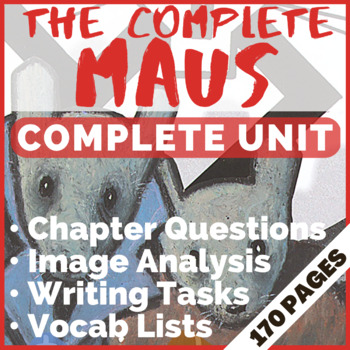THE COMPLETE MAUS Unit Plan: EDITABLE Discussion Questions, Worksheets, Quizzes
- Zip
What educators are saying
Also included in
- UPDATED FOR THE 2024-2025 SCHOOL YEAR: Full-Year Curriculum in American Literature! Diverse Authors! Discussion-Based!This MEGA-BUNDLE has everything you'll need to teach a year-long course on American Literature. The curriculum features 10 UNITS that focus on canonical literary texts written by DIVPrice $99.00Original Price $265.89Save $166.89
Description
UPDATED in 2024: Rigorous! Discussion-based! Informed by the latest cutting-edge scholarship!....
This 170-page EDITABLE curriculum has everything you'll need for profoundly stimulating lessons on Art Spiegelman's The Complete Maus!! Invite your class to engage in student-driven discussions without compromising on intellectual rigor. The pre-reading handouts, discussion questions, vocabulary lists, and analytical writing assignment will challenge your students to dig beneath the surface of the text and generate profound interpretive insights!!
The graphic novel is an aesthetically innovative genre in which meaning is created through the interplay of image and text. How do we read a novel in which two narrative channels — one verbal, the other visual — interact? And how do graphic novels challenge readers to expand the set of interpretive techniques that make up “close reading”? This bundle will help students understand complex questions about literary genres, aesthetic form, social and political history, and the responsibilities that come with representing historical atrocities like the Holocaust.
Here are some highlights from the 170-page curriculum:
• Pre-Reading Activity: Open this unit by reading and discussing Art Spiegelman's early 3-page comic, "Maus" (which was published in an underground comics magazine called Funny Animals in 1972). In addition to the 3-page comic itself, this unit features a double-sided Image Analysis Worksheet in which students encounter questions that will deepen their engagement with Maus. Answer key included. (10 pages)
• Discussion Question Handouts: Thirty-five pages of deeply thought-provoking discussion questions! One double-sided handout containing 8-10 questions for each of the book's 10 sections. The discussion questions are the beating heart of these lesson plans. Every discussion question is grounded in concrete textual details and challenges students to arrive at lucid interpretive insights! The questions could be used to focus students’ thinking prior to beginning a discussion, to foster in-class writing such as stop-and-jots, or to assign written reflections for homework. Guaranteed to elicit student engagement and foster profound discussions! (25 pages)
• Discussion Question Answer Keys: The answer keys to the discussion questions are informed by cutting-edge scholarship by historians and literature professors who specialize on topics like the Holocaust and Spiegelman's Maus. Of course, there is rarely a single "correct" answer for any question; rather, the discussions questions are made up of higher-order questions designed to foster lively exchanges and interpretive debates among students. They challenge students to build interpretive arguments that require the support of carefully selected textual evidence. (50 pages)
• Quick Writes: A "quick write" can be used at any time in a class to get students to pause and reflect on the text in writing. Introduce a quick write before you begin a discussion to allow students to collect their thoughts. Or roll one out toward the end of a discussion to let students capture and refine their best ideas. (10 pages)
• Image Analysis Worksheets: Three double-sided worksheets challenge students to analyze 10 visually complex panels from Maus. Students will reflect on how Spiegelman builds meaning by through the use of aesthetic strategies such as visual parallels, visual puns, symbolism, strategic ambiguity, the interweaving of past and present, etc. Help students figure out what it means to "close read" a graphic novel. Answer keys included. (10 pages)
• Quotation Race Worksheet: Students work in pairs to identify the speakers of 30 key quotations from Maus. Introduce this fun activity when you need to mix things up, or to refresh students' memories in preparation for the AP exam. Answer key included. (4 pages)
• Vocabulary Lists: Lists of 8 vocabulary words for every chapter, complete with definitions and sample sentences with the words as they are used in Maus. A total of 80 words. (10 pages)
• Reading & Vocabulary Quizzes: Daily quizzes with 10 questions on the nightly reading homework plus another 5 questions on the vocabulary words. If you choose not to have your students study vocabulary, you can still use the portion of the quiz devoted to reading comprehension. Grading these quizzes is simple and quick. They’re an easy way to log 10 grades into your gradebook. Answer keys included. (40 pages)
• Analytical Writing Assignment: Challenge students to take their interpretations one step further by writing an analytical paper on Art Spiegelman's complex graphic novel. Let students choose from one of four thought-provoking sample topics — or invite them to develop a similar topic of their own. Writing schedule and rubric included. (4 pages)
The resource packet will come to you in two separate formats: Word docs *and* PDFs. Because the Word doc is editable, you'll be able to customize the materials to suit your teaching style and/or the needs of particular students — year after year. If you don't have Microsoft Word, you'll still be able to access the PDF version, which is easy to navigate and quick to print!
Finally, because I believe that teachers on TpT should be able to see what they'd be getting before they make a purchase, the preview for this resource provides access to 50 pages from this 170-page bundle. Click on the green “preview” button to see exactly what you’ll get....
Thank you for choosing “Rigorous Resources”!!
Happy teaching!
Adam Jernigan, Ph.D.
adamjernigan@gmail.com
P.S. Don't forget to click “follow” for email updates on new products by Rigorous Resources. New products will be 50% OFF for the first 24 hours!






